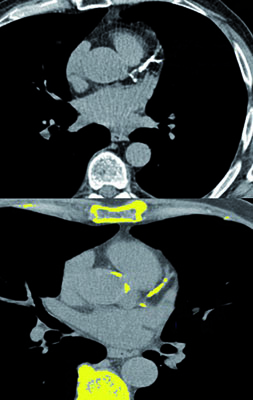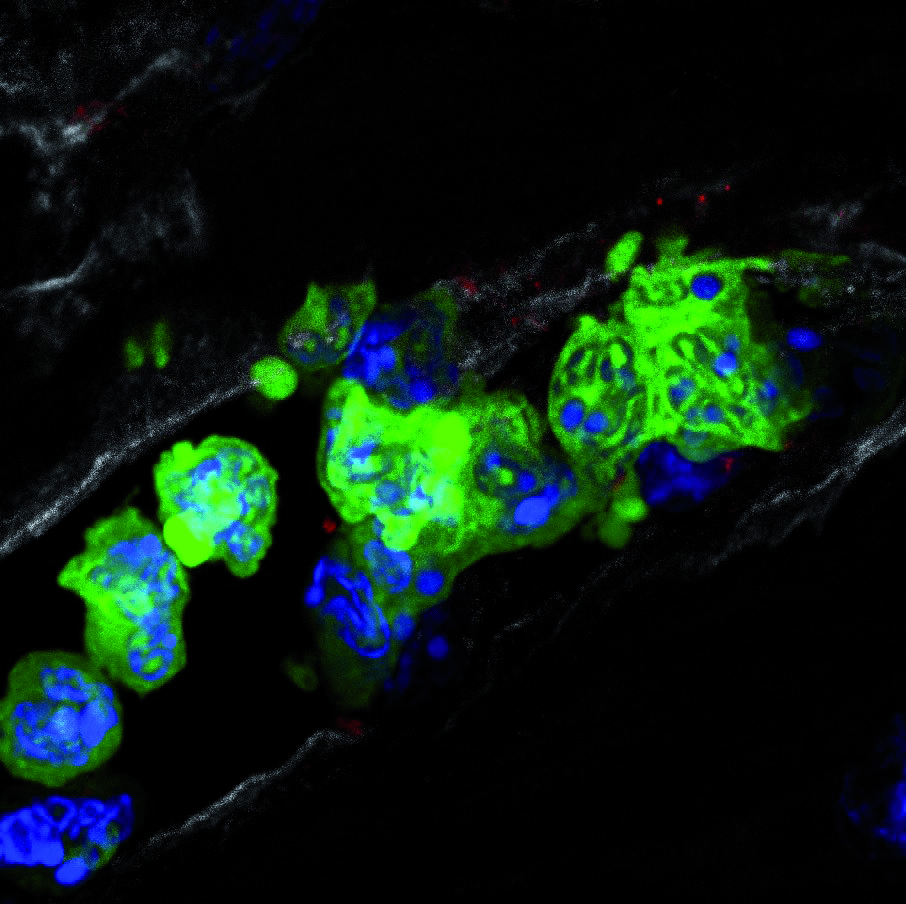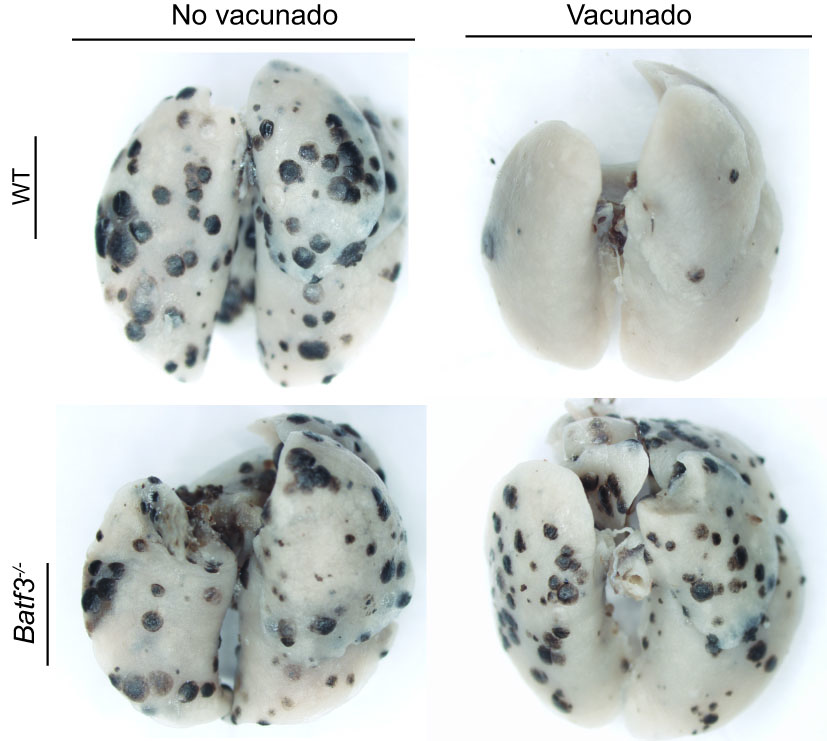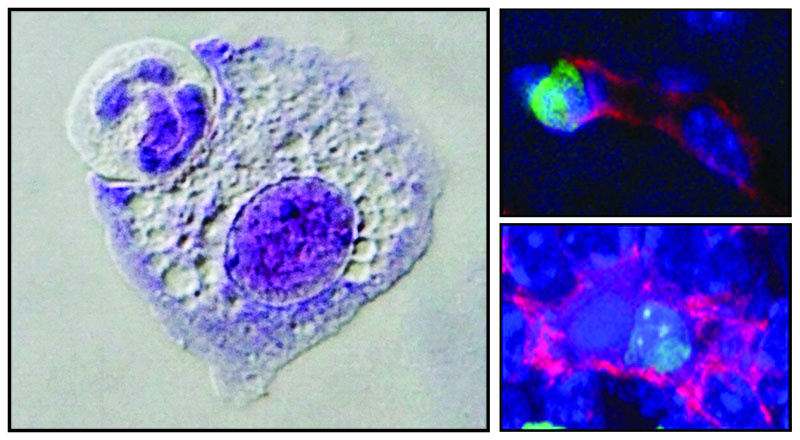Scientific highlights
1. New methods for analyzing gene function
A study published by CNIC scientists in Cell will allow any researcher to induce and analyze multispectral genetic mosaics in vertebrate models such as mice and zebrafish. The new technology will allow a high spatio-temporal resolution definition of the function and interaction of genes during development and disease. Genes encode the information needed to synthesize proteins, the functional building blocks of our cells.
According to study leader Rui Benedito, the improved methods for studying gene function will allow researchers to “increase knowledge about how the genome operates in the multiple cell types that make up our bodies and understand gene interaction networks and their regulatory hierarchies.” This knowledge, moreover, is crucial for the design of efficient therapeutic strategies to modify or correct genetic activity in disease
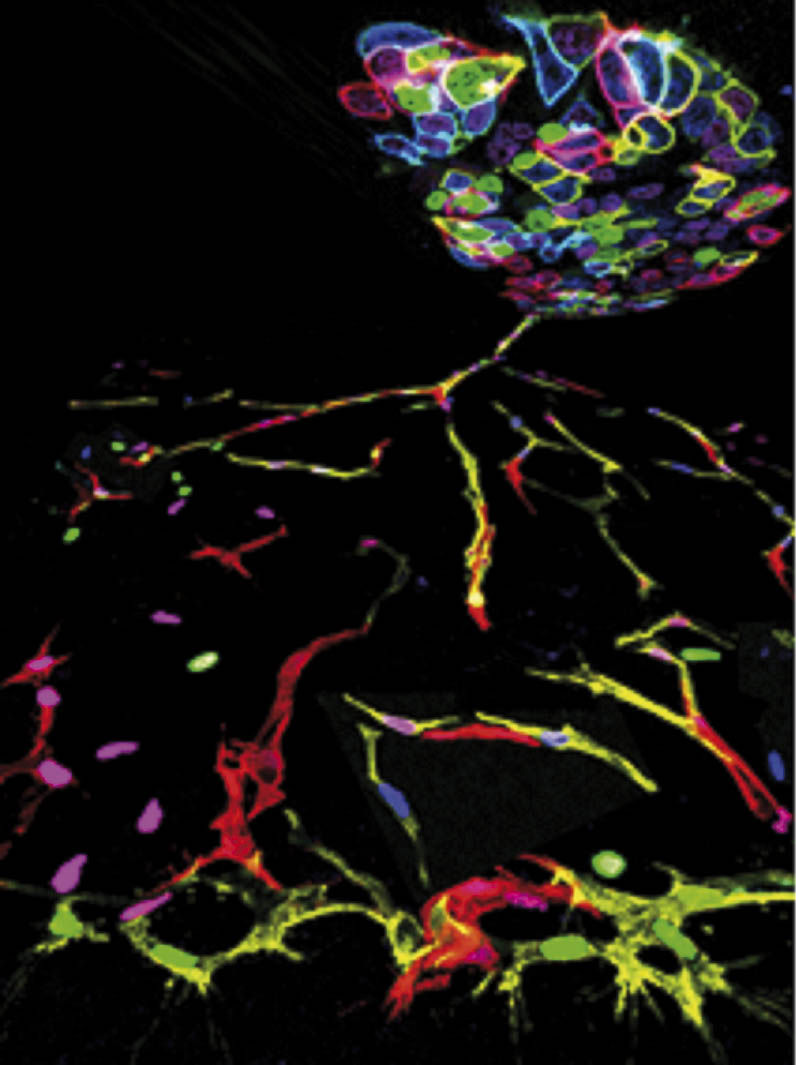
2. Inhibition of a specific protein prevents and reverses aortic aneurysm in models of Marfan syndrome and similar diseases
The inhibition of a protein—inducible nitric oxide synthase, or Nos2—in the arterial wall is able to reverse aortic disease in a mouse model of Marfan syndrome and other types of aneurysm. The findings, published in Nature Medicine, suggest a major potential for Nos2 inhibitors in the treatment of thoracic aortic aneurysm. The study was codirected by Miguel Campanero of the CSIC Instituto de Investigaciones Biomédicas Alberto Sols and CNIC scientist Juan Miguel Redondo.
An aneurysm is a swelling or abnormal enlargement of a portion of an artery, resulting from a pathological weakness in the blood vessel wall. For long periods, an aneurysm is an indolent condition that provokes minimal or no symptoms; however, it is an extremely dangerous condition prone to sudden, catastrophic, and often fatal complications. Effective treatment therefore requires early and accurate diagnosis, close patient management, and surgical repair when conditions allow. The vessel dilatation increases the risk of arterial rupture, and current pharmacological treatments are therefore aimed at reducing pressure on the vessel wall. However, these treatments are of limited use because they do not arrest the deterioration of the aortic wall in aortic diseases, including Marfan syndrome, a disease caused by defects in the fibrilin-1 gene. The only truly effective therapy available is surgery, but this dangerous intervention is indicated only when the risk of surgery is lower than the risk of rupture. Moreover, surgery does not cure or stem the underlying condition, which is progressive and not confined to a specific artery wall segment. There is therefore a need to identify the mechanisms underlying aortic wall degeneration and to discover new pharmacological targets for slowing the natural progression of these diseases.
The research team on this study identified two potential therapeutic targets for the treatment and prevention of aneurysm: the metalloproteinase Adamts1 and the nitric oxide synthase Nos2. The study demonstrates that mice lacking Adamts1 develop a disease similar to Marfan syndrome and that the genetic inactivation of Nos2 expression prevents aortic disease in these mice and in a mouse model of Marfan syndrome. But the study goes further, also demonstrating that pharmacological inhibition of nitric oxide production rapidly and effectively reverses aortic dilatation and aortic medial layer deterioration, both in mice lacking Adamts1 and in the mouse Marfan syndrome model.
Describing the study, Redondo affirmed that it “shows that pharmacological inhibition of Nos2 not only prevents thoracic aortic disease, but also is also curative.” The researchers also confirmed that the Nos2 inhibitor 1400W is equally effective in young and old Marfan mice, suggesting that Nos2 is essential for both disease initiation and progression. The authors recognize the need for caution in extrapolating results from mouse models to the human disease; however, Campanero was keen to underline that “the strong and extremely fast action of Nos2 inhibition in reversing aortic disease in the mouse models fully justifies the initiation of preclinical and clinical trials with Nos2 inhibitors, both for Marfan syndrome and for other aortic diseases.” The safety of Nos2 inhibitors has been demonstrated in clinical trials targeting other diseases, including rheumatoid arthritis, migraine, and endotoxemia, and therefore specific Nos2 inhibitors could be brought into use to treat aortic disease within a very short time frame

3. A new anti-cancer drug linked to cardiovascular problems
Inhibitors of the enzyme Plk1 were recently authorized as an “innovative therapy for leukemia” by the US Food and Drug Administration (FDA). However, a study published in Nature Medicine by researchers from the Spanish National Cancer Research Center (CNIO) in collaboration with researchers at the CNIC suggests that prolonged use of these inhibitors can lead not only to hypertension but also to blood vessel rupture and severe cardiovascular problems.
Progress toward personalized medicine depends on knowing the function of each of our genes and proteins and selecting the appropriate drugs targeting these proteins according to the specific alterations in each patient. In recent years, regulators of the cell cycle, the process that controls the proliferation of all cells, including tumor cells, have demonstrated their usefulness against various cancers, including breast cancer. Among the new drugs used in this strategy is the Plk1 inhibitor volasertib, which has shown very promising results in acute myeloid leukemia and was recently recognized as an “innovative therapy” by the FDA due to its effectiveness against this type of tumor in clinical trials.
In the new study, the CNIC research group led by Juan Miguel Redondo articipated in the characterization of cardiovascular defects in mice with decreased Plk1 activity, resulting from genetic deficiency or treatment with volasertib. Together with scientists at the Centro de Investigación del Cáncer in Salamanca, the Universidad de Salamanca, and the London Research Institute, the CNIO and CNIC team found that while volasertib treatment of a mouse strain with low Plk1 levels did not cause growth defects, it did cause artery rupture and secondary cardiovascular effects. These results indicated that the arteries are more sensitive to Plk1 inhibition than other adult tissues. The team went on to show that Plk1 is essential for the contraction of cells lining the artery wall, an essential process for maintaining an appropriate blood pressure.
Cardiovascular disease and cancer are the main causes of morbidity and mortality in modern societies. The involvement of Plk1 in the control of both processes will have a major impact on future biomedical developments.
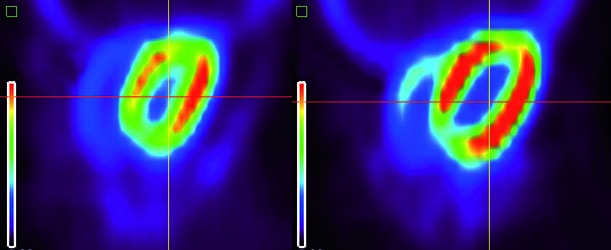
4. Clustering for health
Our immune system protects us from multiple threats such as disease-causing microbes and cancer. However, when our immune system is activated inappropriately, it attacks the body and causes autoimmune diseases. Historically, autoimmunity has been considered the result of immunesystem hyperactivity. Recently it has become clear that autoimmunity can also occur as the result of weakened immune responses. In this situation, a strategy based on pharmacological inhibitors would be counterproductive, and an appropriate strategy would be activation or substitution. Working with this new concept, researchers at the University of Freiburg (Germany) and the CNIC have identified the protein caveolin-1 as a key regulator in a unique model of autoimmunity caused by insufficient immune function.
The team identified caveolin-1 as a crucial regulator of the clustering of receptors in the plasma membrane of B lymphocytes. Using experimental models, the authors showed that, in the absence of caveolin-1, B cell receptors are disorganized and, crucially, do not efficiently detect threats. As a result, B cells are not activated appropriately and generate deficient immune responses. These results demonstrate for the first time that the organization of receptors in the B cell membrane ensures the correct activation of these cells.
5. Spanish research confirms the importance of breakfast in the prevention of cardiovascular disease
Skipping breakfast or eating very little at the start of the day doubles the risk of atherosclerosis. This is the latest finding from the Progression and Early Detection of Atherosclerosis study (PESA), led by the CNIC in partnership with Banco Santander, and published in the Journal of the American College of Cardiology. The report shows that people whose breakfast contains less than 5% of the recommended daily calorie intake (100 calories of a daily intake of 2000) have on average twice the number of atherosclerotic lesions as those who eat a high-energy breakfast. This increased risk, moreover, is independent of classical risk factors such as smoking, high cholesterol, and physical inactivity. The report not only confirms the importance of eating breakfast for cardiovascular health, but also suggests that skipping breakfast could indicate more generally unhealthy eating and lifestyle habits.
6. 3D visualization of cholesterol plaques improves cardiovascular risk prediction
Three-dimensional ultrasound could become a central tool for identifying individuals at risk of developing cardiovascular disease. This is the conclusion of a report, published in the Journal of the American College of Cardiology, from the CNIC-Santander PESA study (Progression of Early Subclinical Atherosclerosis), a collaborative project between the CNIC and Banco Santander that studies more than 4000 middle-aged participants. The report demonstrates that total atherosclerosis burden is a very useful parameter in the stratification of individual cardiovascular risk, when considered together with classical risk factors (blood cholesterol, blood pressure, diabetes, smoking status, exercise, and obesity).
The results of the study, directed by CNIC Director General Valentín Fuster, show that among the study participants (mean age 45 years) the total atherosclerosis burden is twice as high in men as in women (63.4 versus 25.7 cubic millimeters), is higher in the femoral arteries than in other vascular territories, and increases with age.
The CNIC scientists explored the most atherosclerosis-prone regions of the carotid and femoral arteries. In each territory, the researchers performed 3D ultrasound examinations of 6 cm arterial segments in both branches, centered on the carotid sinus and the femoral bifurcation. The study population included 3860 middle-aged participants with no disease symptoms and no history of MI or stroke. All participants were Banco Santander employees based in Madrid. PESA is a prospective cohort study that monitors patients over several years. The patients were examined with a new ultrasound system made by CNIC technology partner Philips. The system uses a linear volumetric transducer that acquires 3D images of the arteries and atherosclerotic plaques.
Although 3D ultrasound is still in the development phase, it has already shown clinical promise in several areas, including quantification of atherosclerotic plaque volume. Direct quantification of plaque volume by 3D ultrasound is more accurate tan 2D techniques for estimating an individual’s total plaque burden.
Borja Ibáñez, CNIC Research Director and a cardiologist at Fundación Jiménez Díaz university hospital, commented that “conventional risk factors (blood cholesterol, hypertension, smoking, etc.) allow a broad prediction of the population risk of severe cardiovascular events (infarction or stroke); however, individualized predictions based on these risk factors are not very accurate. Now, with the ability to directly visualize atherosclerotic plaques and quantify their number and size in the body, we will be able to predict individual risk more accurately. The presence and extent of atherosclerosis gives direct information about how risk factors affect the arteries in each individual.”
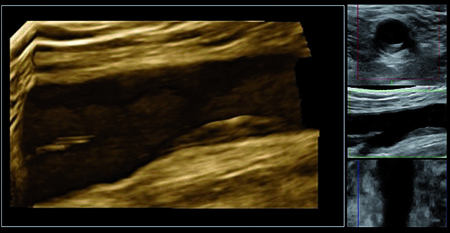
7. LDL cholesterol is the main modifiable predictor of atherosclerosis in individuals with no risk factors
LDL cholesterol (LDL-C), known as ‘bad’ cholesterol, is the underlying reason why many apparently healthy individuals have a heart attack or stroke during middle age despite having no cardiovascular risk factors such as hypertension, smoking, obesity, dyslipidemia, or diabetes. Even at levels considered normal, LDL-C, after age and being male, is the main predictor of the presence of atherosclerotic plaques in the arteries. This is the finding of research conducted at the CNIC and published in the Journal of the American College of Cardiology. The results of the study, led by CNIC Director Valentín Fuster, support the use of more aggressive strategies to reduce LDL-C, including for individuals considered at minimum risk. Fortunately, LDL-C is relatively easy to modify and thus avoid the appearance of atherosclerotic plaques. The new findings have important societal and clinical implications because they demonstrate the importance of aggressively reducing LDL-C, both on an individual level and in the general population. The new findings come from a subanalysis of the PESA study (Progression of Early Subclinical therosclerosis). PESA is a joint project between the CNIC and Banco Santander that uses the latest noninvasive vascular imaging technology (magnetic resonance, PET, CT, and 2D and 3D ultrasound) to answer important unresolved questions about cardiovascular isease, such as when and how it begins and what has to happen for it to manifest clinically.
8. Five health indicators are enough to predict cardiovascular risk in healthy people
Just five indicators of cardiovascular health—blood pressure, physical activity, body-mass index, fruit and vegetable intake, and smoking status—accurately predict cardiovascular risk in healthy individuals. This is the conclusion of a study carried out at the CNIC and published in The Journal of American College of Cardiology. The study demonstrates that the Fuster-BEWAT score, which is based on these five cardiovascular health indicators, effectively predicts the presence and extent of subclinical (asymptomatic) atherosclerosis in healthy middleaged individuals with no known history of cardiovascular disease. Moreover, Fuster-BEWAT predictions are as accurate as those obtained with the widely used Ideal Cardiovascular Health Index (ICHS), the score currently recommended by the American Heart Association, which additionally includes blood analysis of cholesterol and glucose. The new study forms part of the Progression and Early Detection of Atherosclerosis project (PESA), a CNIC initiative conducted in partnership with Banco Santander. The results demonstrate the usefulness of the Fuster-BEWAT score for evaluating cardiovascular risk in situations where it is not possible to obtain blood samples.
9. Dogma overturned: new studies into inflammation in the infarcted heart could lead to changes in therapy
Scientists at the CNIC and the Fundación Jiménez Díaz (FJD) and Salamanca University Hospitals have demonstrated that the human heart responds very differently to an infarction than was previously thought. The study, published in two independent articles in the leading journals Circulation and Circulation Research, overturns the established view that an infarction is followed by progressive repair of the myocardium.
The project arose from research begun more than 10 years ago at Mount Sinai Hospital in New York, directed by Valentín Fuster, who is an author on both of the new CNIC-led studies. Two years ago, the CNIC and the FJD University Hospital signed a collaboration agreement to coordinate their studies of cardiac muscle after an acute MI. The study is the first in the world to study heart attack patients by MRI so soon after the re-establishment of blood flow. In addition to studies in patients, the team have also extended their investigation of infarction in pigs, the experimental model most similar to humans. The unique translational research infrastructure at the CNIC includes equipment for directly comparable imaging in human and animal studies, allowing the team to demonstrate that treatments during an infarction can change the composition of the cardiac muscle during the first hours after reperfusion and result in a much more rapid recovery of the heart. In the words of study author Rodrigo FernándezJiménez, “MRI provides an extraordinary ability to noninvasively visualize events occurring after an infarction in real time, including inflammation, tissue volume expansion, hemorrhage, and obstruction of the microcirculation.”
The study was coordinated by Ibáñez, Director of Clinical Research at the CNIC and a cardiologist at FJD University Hospital. In his view, the discovery of the bimodal inflammatory response in the human heart “forces us to think about the best timing for MRI scans used in clinical trials to quantify irreversible injury and to monitor the effectiveness of interventions to reduce this injury. Until now, this question was considered unimportant, and cardiac imaging studies have been conducted on any day in the postinfarction period. The new findings show that the optimal time for these scans is between postinfarction days 4 and 7, when the second wave of inflammation/edema is prominent and affects the entire region that was shut off from the blood supply during the infarction.”
This research project was possible thanks to the scientific collaboration between the CNIC and technology partner Philips Iberia. Physicist Javier Sánchez-González, a Philips researcher seconded Scientific Report 19 to the CNIC, leads the technological development of these cardiac imaging projects, and his input is essential for transferring the initial findings from the CNIC to collaborating hospitals, so that the new algorithms can be tested in a clinical environment.
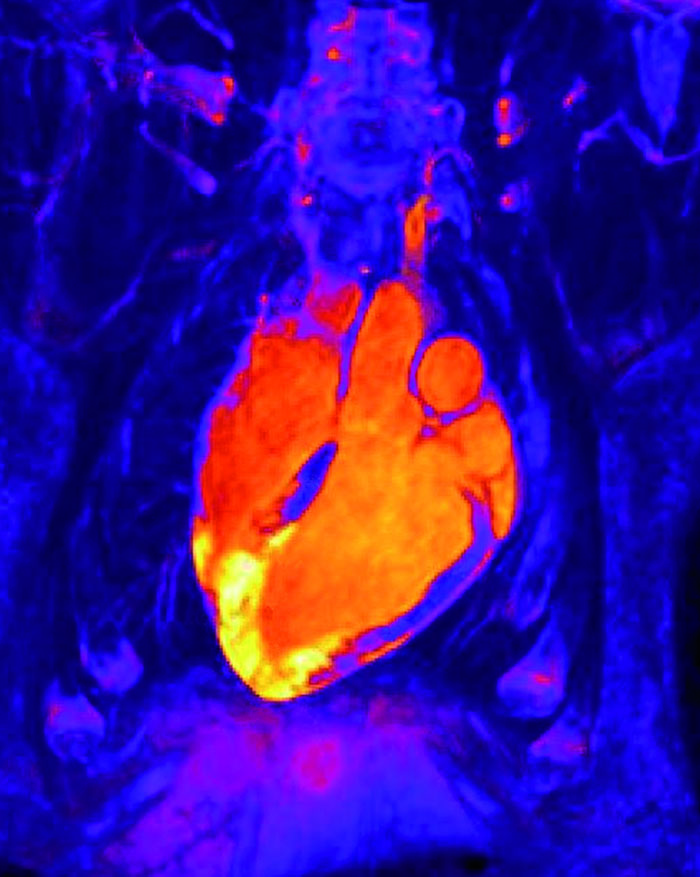
10. A new treatment target for aggressive lymphomas
An estimated 400,000 people worldwide are diagnosed with lymphoma every year, and B cell lymphomas kill more than 200,000 people every year. CNIC scientists have identified a possible therapeutic target for two types of very aggressive lymphoma. The CNIC team discovered that the microRNA miR-28 regulates the terminal differentiation of B lymphocytes, blocking the growth of B cell lymphomas. The study, published in Blood, establishes the therapeutic potential of synthetic miR-28 analogs for inhibiting the growth of Birkitt lymphoma and diffuse large cell lymphoma. These findings could lead to the development of the first miRNA analog therapy for the treatment of B cell lymphoma and provide the basis for human trials.
11. CNIC scientists discover an essential mechanism in the immune response
A study led by Almudena Ramiro and published in Nature Communications demonstrates an essential role for the transcriptional regulator CTCF in antibody production. The research shows that CTCF is required for the ability of B lymphocytes to correctly protect the body against infection. In the absence of CTCF, the immune system does not function correctly, a finding with implications for vaccine research. The study reveals an essential function for CTCF in the orchestration of transcriptional changes during the terminal differentiation of B lymphocytes and advances our 20 Scientific Report 2017 understanding of the mechanisms that regulate the immune response.
12. A specific protein regulates the burning of body fat to generate heat
CNIC scientists have identified a protein that holds promise as a target for therapies to reduce obesity. Drs. Guadalupe Sabio and Nuria Matesanz have demonstrated that MKK6 controls the conversion of fat stores, known as white fat, into brown fat, in which lipids are burned to maintain body temperature and reduce obesity. Obesity is a global epidemic, with overweight or obesity affecting an estimated 2200 million people worldwide. In the study, published in Nature Communications, the research team showed that the elimination of MKK6 stopped the progression of obesity in mice and led to body mass reductions. These results confirm MKK6 as a potential therapeutic target in the fight against obesity.
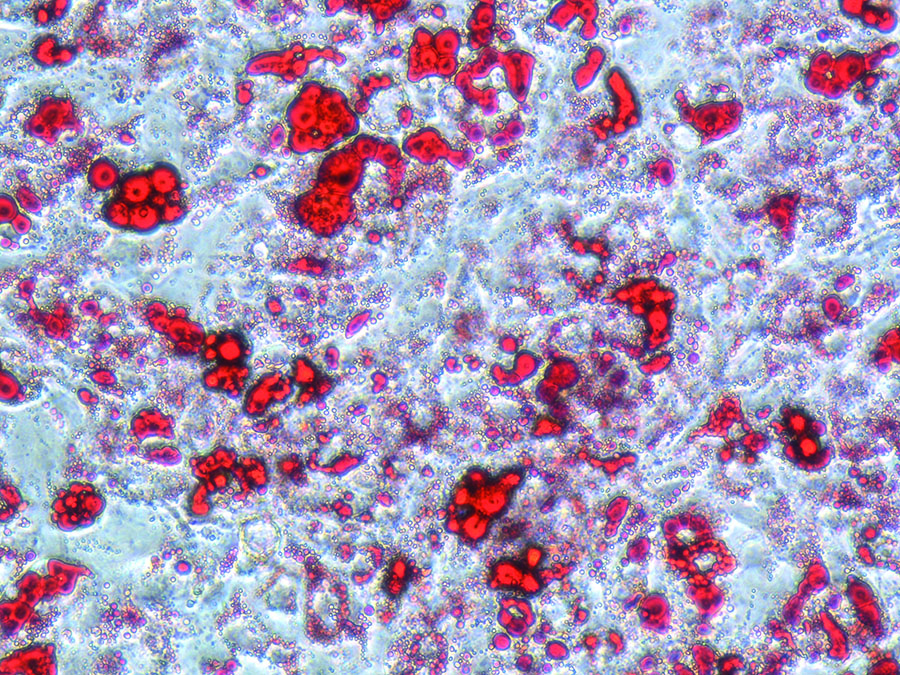
13. A decades-old drug stops the spread of injury after a heart attack
Acute myocardial infarction is a serious disease that affects more than 50,000 people a year in Spain. Treatment has advanced a great deal in recent years, especially in the extensive use of coronary angioplasty, in which a catheter is used to reestablish blood flow through the blocked coronary artery. Nevertheless, many heart attack survivors have seriously impaired heart function that limits their long-term health and generates major health system costs. The search for treatments to limit the irreversible damage caused by a heart attack is an extremely important research area in relation to both patient care and health policy. In an article published in Nature Communications, CNIC scientists report a new mechanism of action of metoprolol, a drug that can limit the damage produced during a heart attack if administered early.
The team led by Borja Ibáñez, CNIC Clinical Research Director and a cardiologist at the Fundación Jiménez Díaz University Hospital Health Research Institute (IIS-FJD), has identified the mechanism that explains why this drug is so beneficial: rapid administration of metoprolol during a heart attack directly inhibits the inflammatory action of neutrophils, a type of blood cell. The reduced inflammation translates into a smaller amount of damaged tissue in the post-infarcted heart. The finding opens the route to new applications for this cheap, safe, and simple drug.
14. The key to improved cancer immunotherapy
CNIC researchers have investigated how different subtypes of essential immune-response cells called CD8+ T lymphocytes cooperate to mount a stronger anti-tumor response. The results show that generation of an optimal immune response to cancer requires cooperation between two types of memory T cell—one circulating in the blood and the other resident in tissues—that can be reactivated with current immunotherapy strategies. These results, published in Nature Communications, have the potential to improve current cancer immunotherapy strategies, especially in relation to the prevention of metastasis (dissemination of the tumor to organs distant from the site of origin).
Immunotherapy—the use of the immune system to fight cancer—is revolutionizing treatment, and was selected by the prestigious journal Science as the major scientific advance of 2013. According to study leader David Sancho, “Cancer evades the control of the immune system because the cytotoxic T lymphocytes that should recognize and eliminate tumor cells are inhibited. Current immunotherapy is based on reactivating these T lymphocytes; however, little is known about how cytotoxic T cells can be generated more effectively, and in particular how immune memory can be triggered to prevent the development of tumors and metastasis.”
The study suggests that an optimal anti-tumor immune response requires the generation of both circulating and tissue-resident T cell memory. Both memory T cells subtypes can be reactivated with current immunotherapy treatments, and reactivation of both requires DC1 dendritic cells. Cancer immunotherapy is not simply a treatment that can effectively promote the rejection of primary tumors; above all, it is a fundamental tool for impeding metastasis after surgery to remove the primary tumor.
15. Cell “cannibalism” trains our defenses
Phagocytosis is a biological mechanism whereby specialized cells ingest and degrade old, dead, or damaged cells to prevent them accumulating and causing tissue damage. A CNIC-led study has now reported that phagocytosis appears also to have an educational role. The Journal of Experimental Medicine report is the fruit of a joint effort by teams from the Spanish National Cancer Research Center (CNIO), the Spanish Superior Scientific Research Council (CSIC), and groups from the USA, and was coordinated by Noelia Alonso-González and Andrés Hidalgo of the CNIC. The study shows that phagocytosis not only eliminates useless cells, but also trains macrophages, the immune cells that carry it out.
It is a paradox of nature that death is a prerequisite for the continuation of life. This is no more evident than in our own bodies, in which billions of cells in the intestine, the blood, the skin, and other tissues die every day so that new ones can take their place. Scientists have long been interested in how organisms eliminate the debris from these expired cells. One of the commonest mechanisms turns out to be that specialized cells eat the old, dead, or damaged cells. This digestive process, called phagocytosis, is carried out by cells called macrophages, a name that means “big eaters”.
An important conclusion of the study is that the act of ingesting expired cells trains the immune system in how to maintain tissues in a clean and healthy state, and that macrophages play a very important role in this process. The study identifies in detail the molecules that carry out important tasks in the phagocytic process in each tissue, from the gut to the liver and bone marrow. Surprisingly, the researchers found that each tissue has its own specific molecular toolkit for eliminating unwanted cells. According to Alonso-González, “This discovery suggests that in principle it should be possible to modulate phagocytosis in individual organs, without altering events in neighboring organs. One could, for example, promote the elimination of dangerous cells in the spleen without risking elimination of beneficial cells in the lung.” Although any therapeutic application lies in the future, the study, in describing how the body maintains itself clean and healthy, suggests that in time it may be possible to coordinate the work of these cleansing macrophages to our benefit.



